When the opening ceremonies of the 2020 Summer Olympics take place on Friday, July 23, in Tokyo’s Olympic Stadium, athletes and representatives from dozens of countries from all over the world will flaunt their nation’s flags as the competition gets underway. But while we’re admiring the parade of brightly colored flags, what we won’t see is the history and meaning behind each one. Every country’s flag is more than just a design—it’s a part of its heritage and can tell us something about its history. So get better acquainted with the nations at this year’s Games by reading the stories behind 25 flags you’ll see in the Olympic opening ceremonies.
1. Ecuador
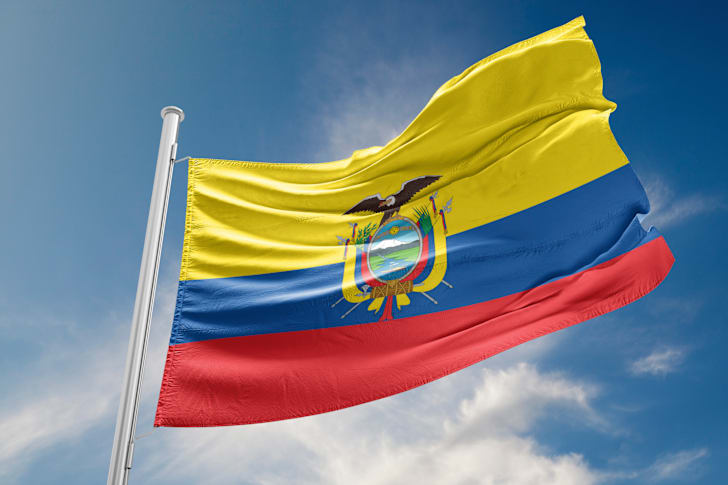
HStocks/iStock via Getty Images Plus
The Ecuadorian flag is made up of three horizontal bands of color: a double-width band of yellow, followed by one blue and then red. The colors themselves all hold significance with yellow representing the abundance of crops and the fertility of the country’s land; the blue symbolizes the sea and sky; and the red represents the blood that was spilled for freedom and independence.
2. Eritrea
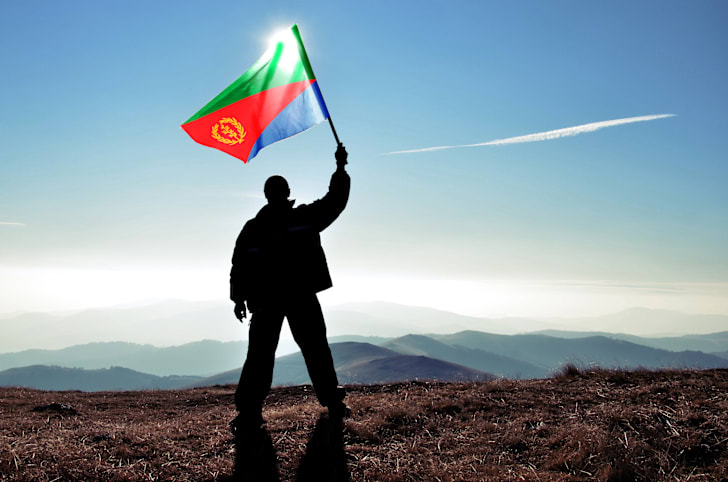
zefart/iStock via Getty Images Plus
The flag of Eritrea features the colors red, green, and blue to represent (again) the blood spilled for freedom, the country’s agriculture, and the bounties of the Red Sea, respectively. The triangle on the flag was inspired by the shape of the country itself, while the 30 leaves of the wreath in the center stand for the number of years the country spent fighting a civil war for independence.
3. Kosovo
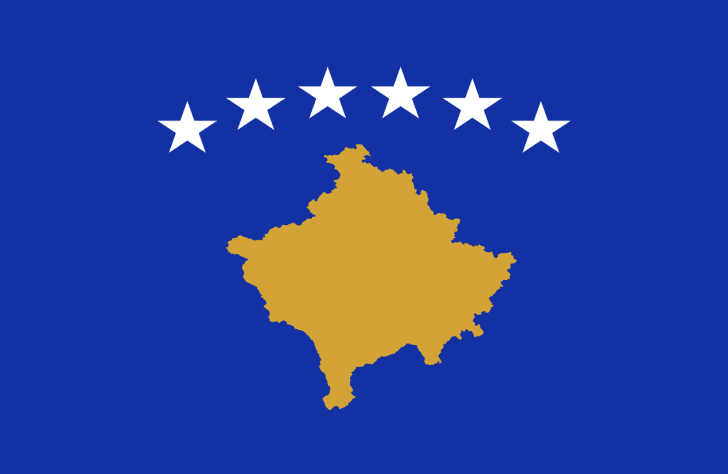
Veronaa/iStock via Getty Images Plus
In the lead-up to the adoption of the Kosovo flag in 2008, the provisional government held a contest to determine what the new design would look like. The current flag features a yellow silhouette of Kosovo itself on a blue background, with six white stars standing for the country’s major ethnic groups: Albanians, Serbians, Turks, Gorani, RAE (Romani, Ashkali, and Kosovo Egyptians), and Bosniaks.
4. Malaysia
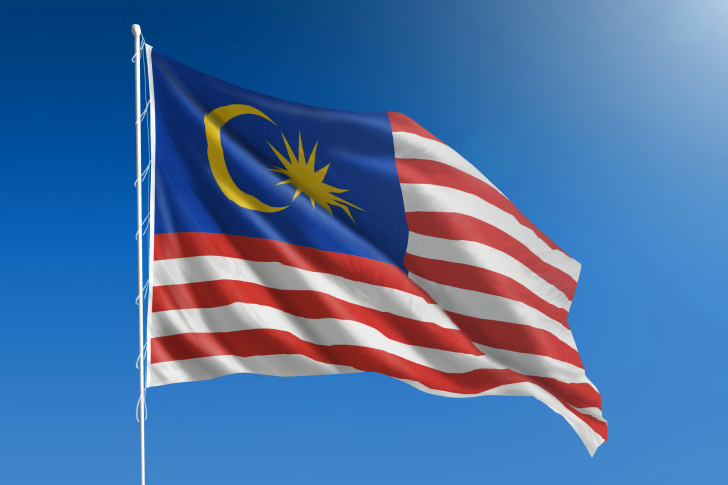
Derek Brumby/iStock via Getty Images Plus
The Malaysian flag features 14 horizontal lines alternating red and white to symbolize the 13 states and federal government of the country. The same is true for the 14 points on the flag’s star, which again represent the states and government, but are here unified to form one shape. The star is then partly surrounded by a crescent representing the nation’s official religion, Islam. Known as the Jalur Gemilang, the flag was designed by Mohamed Hamzah, a public works department architect in the late 1940s. The design was tweaked and finalized before it was flown for the first time on May 19, 1950, and it has evolved as Malaysia’s states have changed over the years.
5. Nigeria
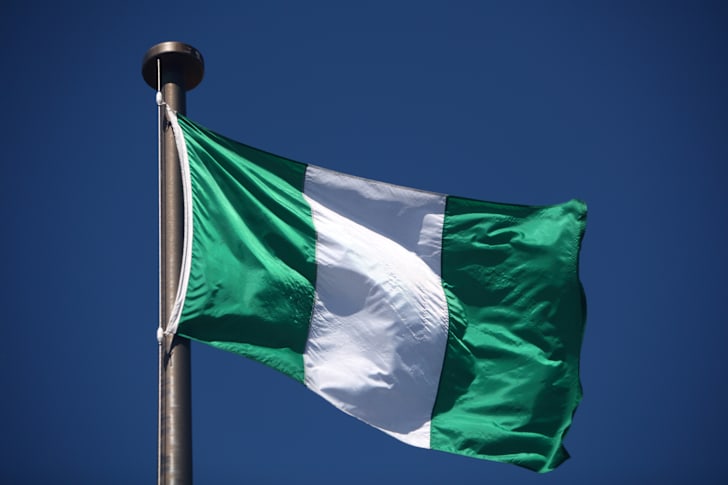
filo/iStock via Getty Images Plus
The Nigerian flag is striking in its simplicity. The bold vertical bands tell the story of the country’s agricultural wealth (green) and its peace and unity (white). The white also represents the Niger River that runs throughout. The flag was designed in 1959 by a 23-year-old named Pa Michael Taiwo Akinkunmi, who came across the opportunity after reading about it in the newspaper while in college. For his work, he won 100 pounds—or roughly $280.
6. Singapore
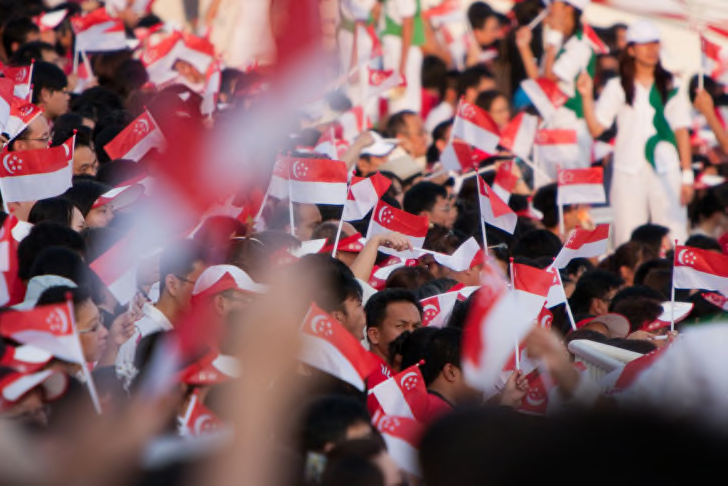
The red and white flag of Singapore makes a bold statement about its ideals. The crescent moon on the flag is meant to represent a young nation growing in power, while the five points on the star prioritize the country’s dedication to democracy, peace, progress, justice, and equality. This flag replaced Britain’s Union Jack in 1959, and the striking red background is meant to represent brotherhood and unity.
7. Argentina
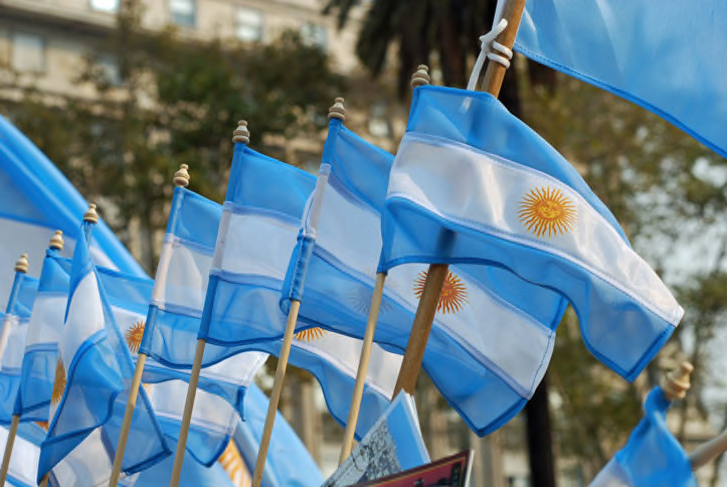
meshaphoto/iStock via Getty Images Plus
The flag of Argentina is famous for its image of the “Sun of May” sitting on band of white, with two bands of blue above and below it. That’s the official flag used for military and official government, and for years civilians could only use an alternate version of the flag without the sun. In 1985, however, that was changed, and now anyone, as long as the proper respect is paid, can flaunt the official Argentinian flag.
8. Ireland
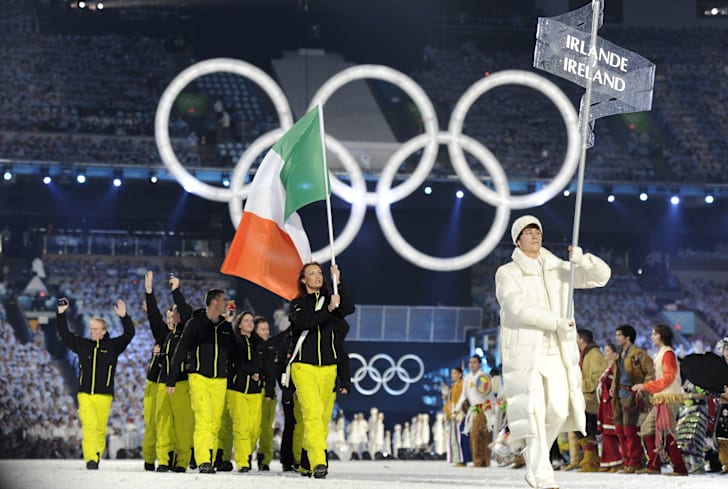
MICHAEL KAPPELER/AFP via Getty Images
The three colors on the Irish flag—green, white, and orange—tell the story of the hopes for the unification of its people. Green stands for the native Irish, who were Catholics; the orange is for the later Protestant settlers from Britain who supported King William III (also known as William of Orange); and the white portion in the middle is there to show the hopes for everlasting peace between the two groups. And if those unique color shades catch your interest, the Pantone code for the green is 347 U and the orange is 151 U.
9. Monaco
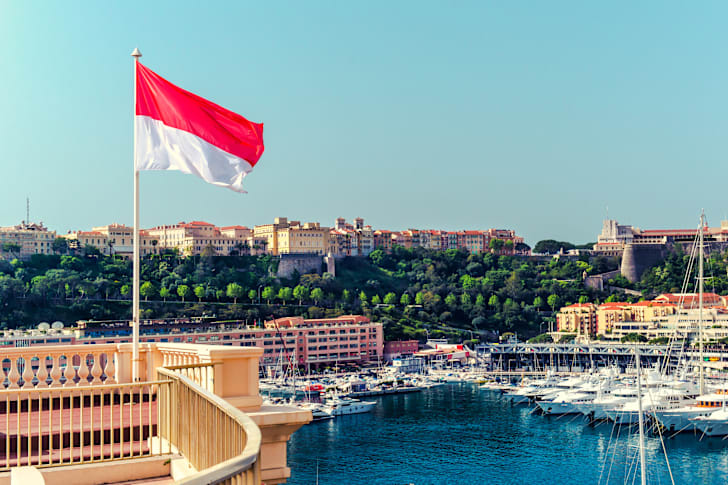
amoklv/iStock via Getty Images Plus
The national flag of Monaco is a simple one—two equal, horizontal bands of red and white. This is the flag that citizens use and it’s the one that represents the country internationally, such as at the United Nations and Olympics. There is, however, another flag that the country uses on its government buildings and for the prince. This one shows off Monaco’s coat of arms on a white background.
10. Poland
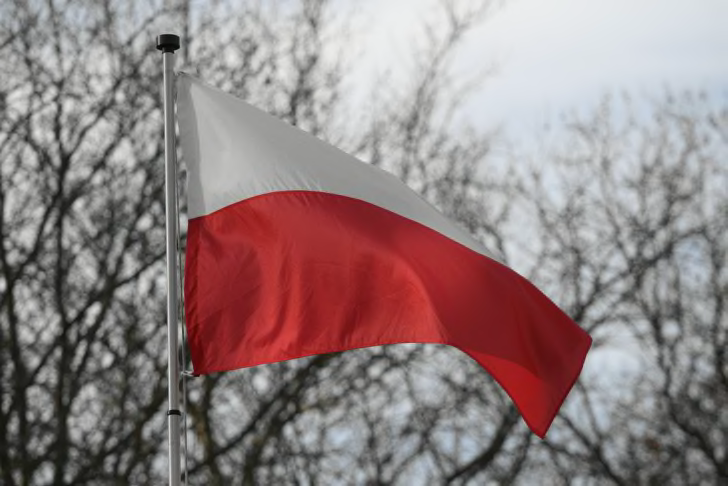
There are two flags associated with Poland—one is the simple red and white design which is the inverse of the flag of Monaco. If history is any guide, this is the flag you’ll see the Olympic athletes use during the opening ceremony. And then there’s the variant with the country’s national emblem—an eagle—displayed on the white portion of the flag. This version is used on Polish government buildings around the globe and on sea vessels.
11. Tonga
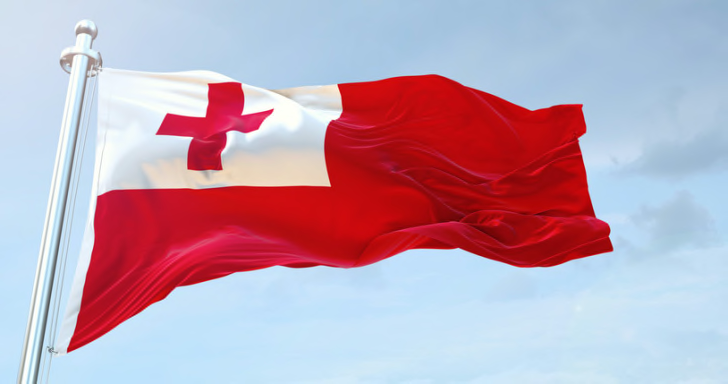
EA/istock via Getty Images Plus
The color red and the image of the cross on the flag of Tonga represent the blood of Christ for a nation that is made up primarily of Christians. And don’t expect the look to change anytime soon—it’s written into the country’s constitution that the design of the flag can never be altered [PDF].
12. Republic of Korea
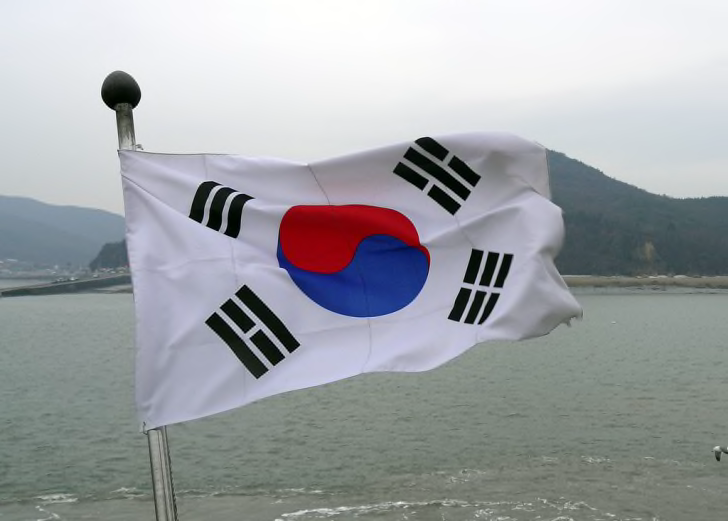
The flag of South Korea is a busy one. The central symbol is the red (Pantone 186 C) and blue (Pantone 294 C) image of Ying-Yang, representing opposites (positive and negative), with four sets of three bars surrounding it. The bars—or Kwae—are meant to elicit a sense balance or harmony. The white background emphasizes the Korean people as unified and peaceful. Though the flag was originally conceived in the late 19th century, it took until 1997 to establish standardized colors [PDF].
13. Estonia
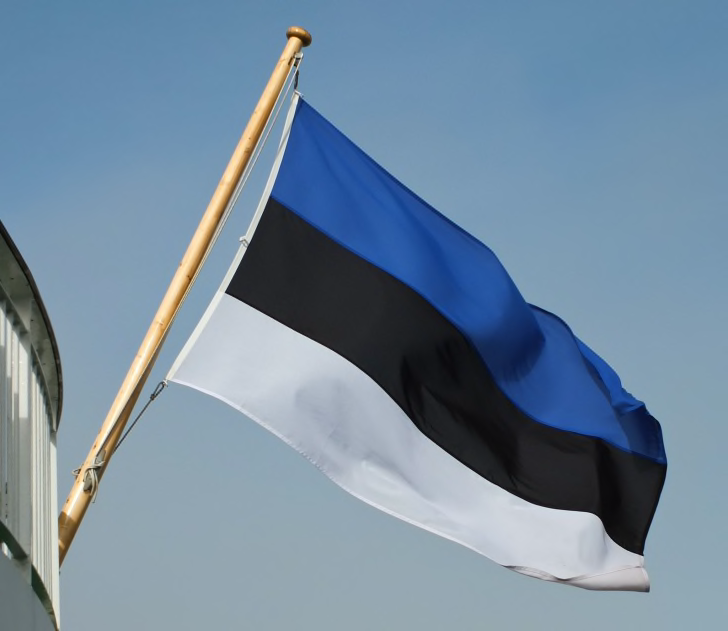
The Estonian flag was originally adopted by the country’s provisional government in 1917 and was used until the Soviet occupation of 1940. The design was immediately banned until the nation regained its freedom and was officially adopted again in 1989. The flag’s blue, black, white colors all represent something of importance to the Estonian way of life—blue for the seas, lakes, and sky; black for the fertile soil; and white for its snowy landscape.
14. Switzerland
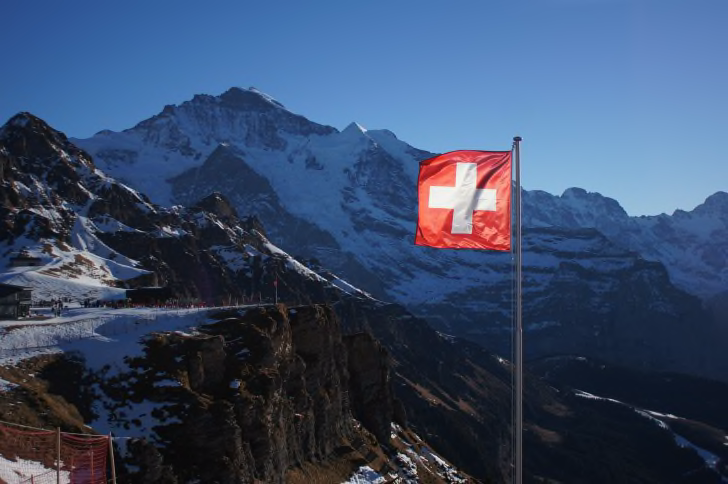
Other than the Vatican, Switzerland is the only sovereign state to have a square flag, rather than the standard rectangle (though some rectangle variants still exist in certain situations). The Red Cross uses the inverse of the Swiss flag, in honor of Henry Dunant, a Swiss businessman whose book A Memory of Solferino helped inspire the idea for the organization.
15. Kyrgyzstan
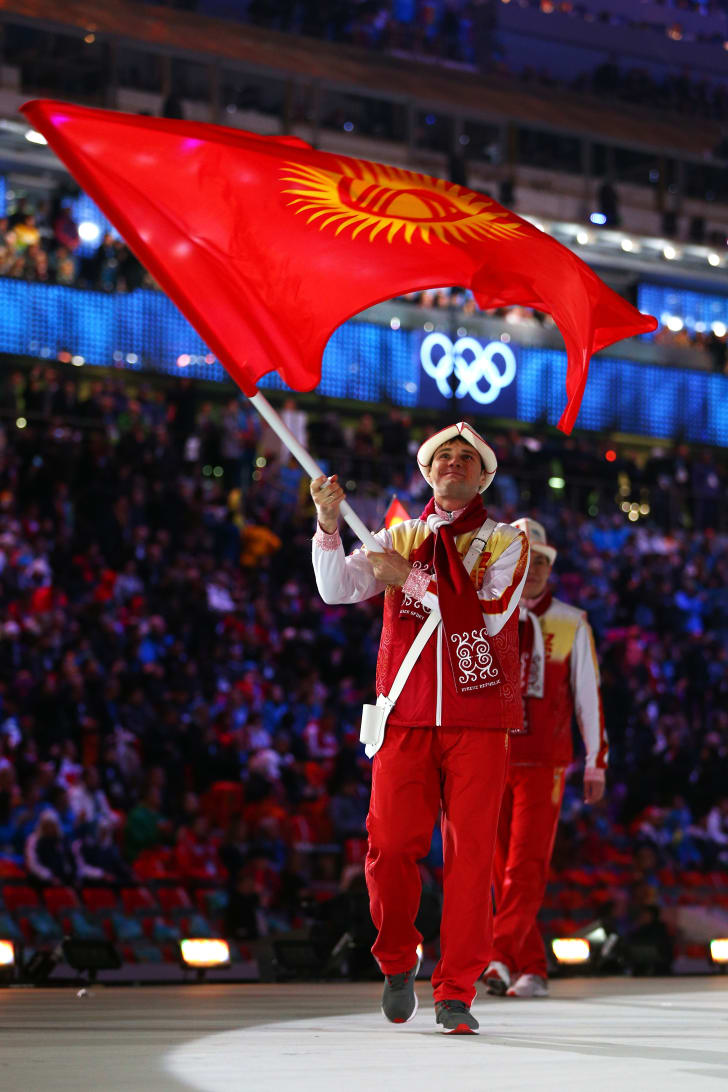
Paul Gilham/Getty Images
The red field that makes up the backbone of the Kyrgyzstan flag is meant to conjure images of “bravery and valor” based on Manas, the country’s national hero. Some, however, are still skeptical of such a bold use of red, fearing that it still retains the DNA of the Soviet regime that the country escaped in the early ’90s.
16. Georgia
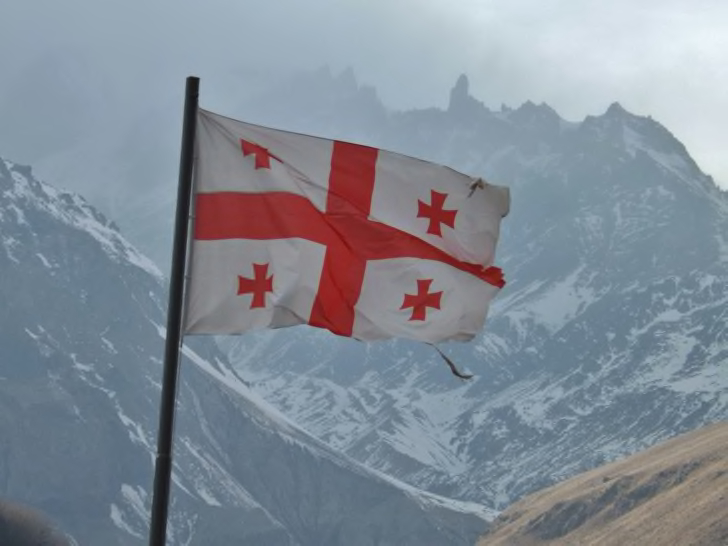
The modern flag of Georgia is relatively new—it was officially adopted by the nation in 2004. It’s similar to flags used intermittently from the 8th through 15th centuries, and the design is fairly simple: four small corner crosses sectioned off by a much larger one in the middle, known as St. George’s cross. The overall design is a take on the “Jerusalem cross,” which some believe symbolizes the five wounds of Christ.
17. Belarus
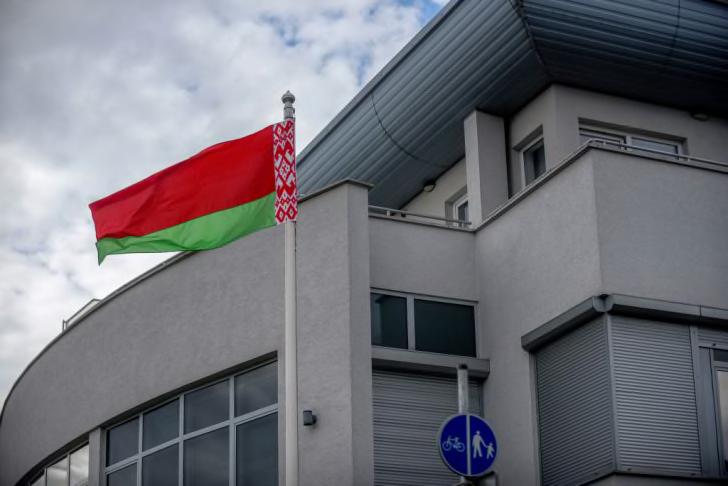
Omar Marques/Getty Images
Like many flags, Belarus’s has colors representing past struggles (red, likely for blood) and hope (green, which also has links to the country’s forests). The one thing that makes the Belarus flag stand out is the red and white ornamentation at its hoist. This was inspired by designs typically found in Belarusian society.
18. Ukraine
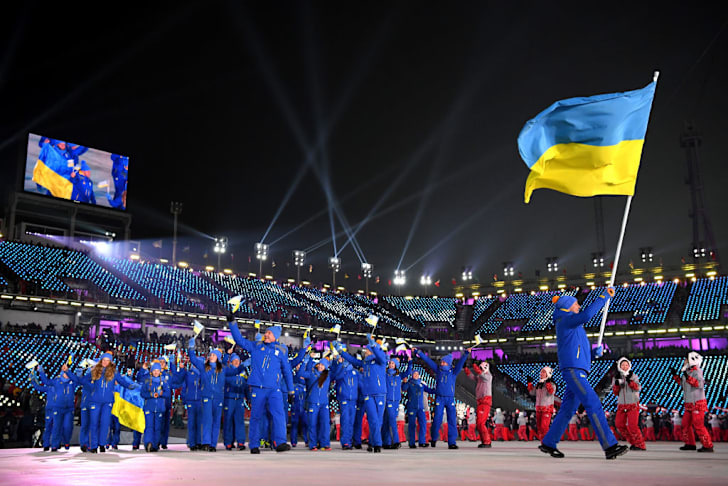
Matthias Hangst/Getty Images
Simple but striking: the Ukrainian flag’s colors are meant to symbolize the country’s fields of wheat (yellow) and blue skies (blue). After the flag’s design was chosen, people would fly the flag with either the blue or yellow at the top, not knowing which way was up or down. It would eventually take an act of parliament in 1918 to cement that the blue goes on top and the yellow at the bottom.
19. Great Britain
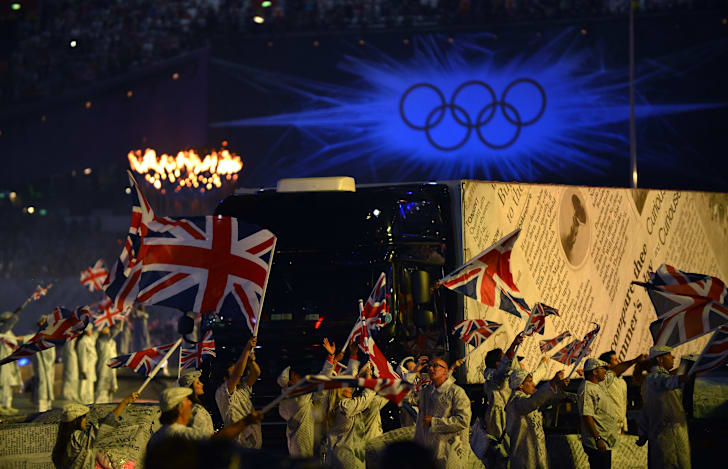
JEWEL SAMAD/AFP/GettyImages
The flag of Great Britain is a composite of three centuries-old flags from the various lands that now make up the United Kingdom: St. George’s Cross of England, St. Patrick’s Cross of Ireland, and St. Andrew’s Cross of Scotland. The process was a long one, though. The first two flags—England and Scotland—were first combined in 1606, leaving almost 200 more years before the union was complete when Great Britain and Ireland united in 1801. And if you’re wondering why Wales isn’t represented on the flag—it’s because Wales and England unified in 1536, predating the idea of a “Union” flag and, well, kind of leaving them out.
20. Ghana
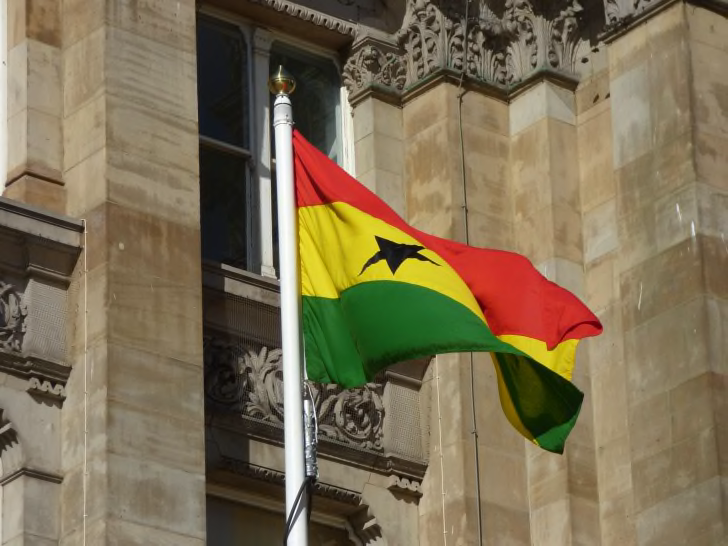
Like many countries, the Ghana flag features red to remember bloodshed, gold to appreciate its natural resources, and green for vegetation. But the stark, black star in the middle is what will catch anyone’s eye. This star represents Africa’s united fight against colonialism and was put in by the flag’s designer Theodosia Salome Okoh.
21. Bosnia and Herzegovina
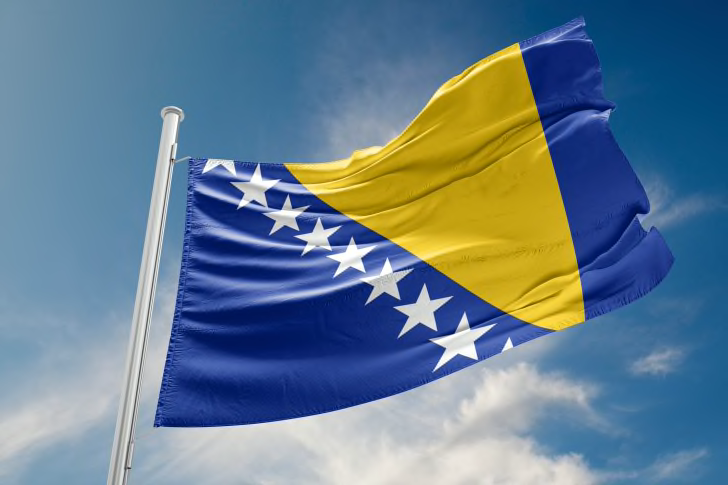
iStock
When the country itself couldn’t settle on a final flag design, Carlos Westendorp, an outsider and the International High Representative for Bosnia, made the choice himself. The three points of the triangle are meant to stand in for the three principal ethnic groups in the country: Muslims, Croats, and Serbs. The blue background calls to mind the flag of the European Union, while the stars are cut in half at the top and bottom for a reason: when the flag is folded, these would form a new, whole star, suggesting unity.
22. Puerto Rico
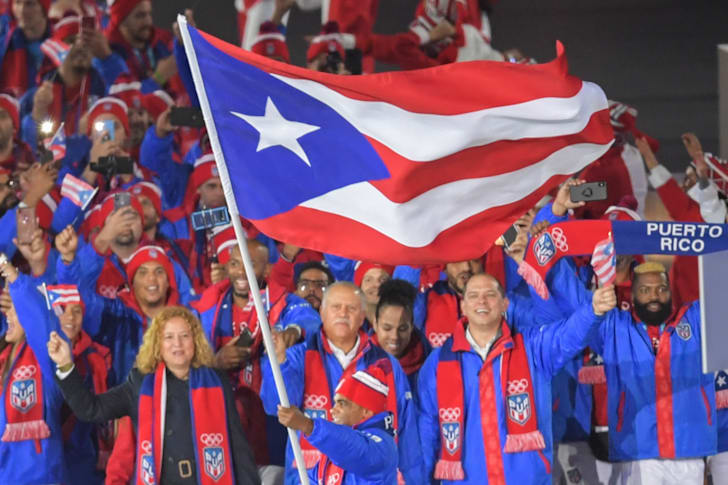
PEDRO PARDO/AFP via Getty Images
Though it has fewer stars and stripes than the similar U.S. flag, Puerto Rico’s is still full of symbolism. The five-pointed star stands for the commonwealth itself, while the three points of the triangle it’s housed in are for the Judicial, Legislative, and Executive branches of government. The red stripes—as is the trend—are for the blood spilled throughout its history, while the white stripes stand for the freedoms afforded to individuals. It was adopted as the national flag when Puerto Rico officially became a commonwealth in 1952.
23. Greece
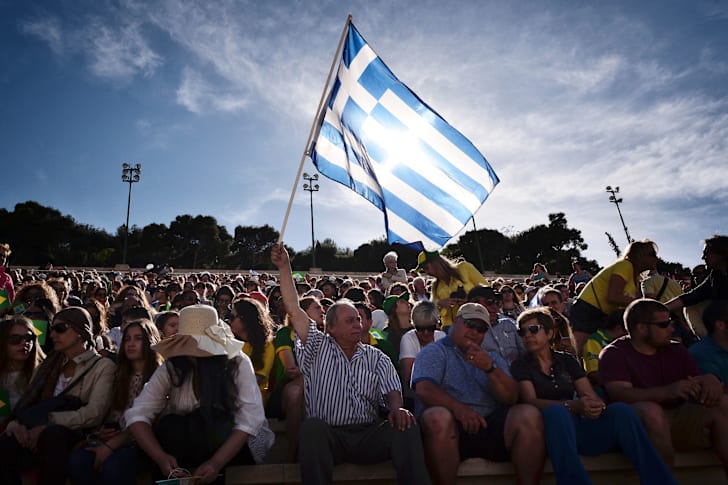
LOUISA GOULIAMAKI/AFP via Getty Images
There are two main thoughts regarding the nine stripes on the Greek flag. For some, each stripe is for a syllable in the phrase Eleftheria H Thanatos or “Freedom or death.” Another story, however, sees them as the nine muses found in Greek mythology, with the blue and white representing the sea and clouds. The historical record regarding the flag’s origin is spotty, and even the exact shade of blue has changed from light to navy over the decades.
24. Japan
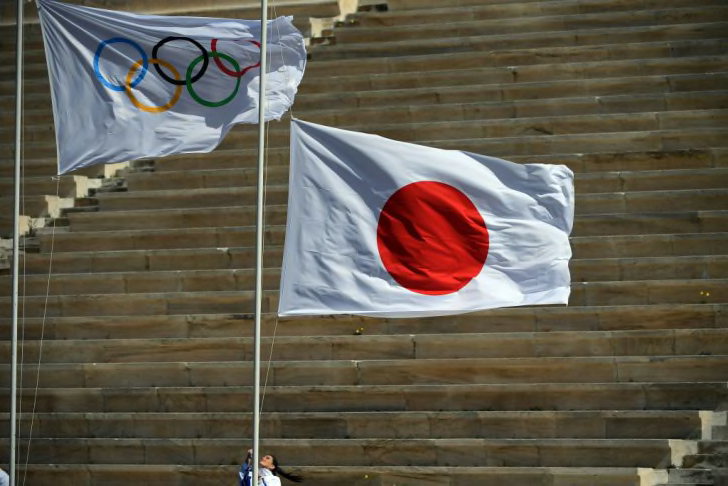
ARIS MESSINIS/POOL/AFP via Getty Images
There are two names given to Japan’s flag: Nisshōki, meaning “sun-mark flag” and Hinomaru or “sun disc.” And while the flag has existed in some form since the early 8th century, it wasn’t officially adopted by the Japanese government until 1999. One variation of the Japanese flag is the “Rising Sun” flag that was prominent in the late 19th century through World War II. It’s still in use today by the Japanese Maritime Defense Force (as well as in certain advertisements) and has become controversial because of its association with the nation’s imperialistic past.
25. The Russian Olympic Committee (ROC)
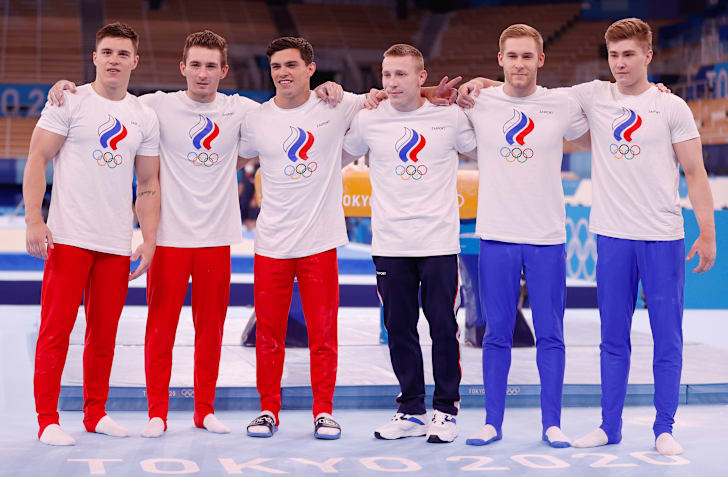
Jamie Squire/Getty Images
The team called the “Russian Olympic Committee”—or ROC—came about following the punishments handed down from the country’s doping scandal. Basically, select athletes from Russia can compete in certain events, but they can’t formally represent their country or fly their flag. Instead, they’ll fly the ROC flag, which you can see on the T-shirts in the picture above. The design incorporates the Olympic rings with a flame-like logo on top in the colors of the current Russian flag.
This article was originally published in 2018; it has been updated for 2021.
The Stories Behind 25 Flags You’ll See in the Olympic Opening Ceremonies
Source: Philippines Wonders
0 Comments